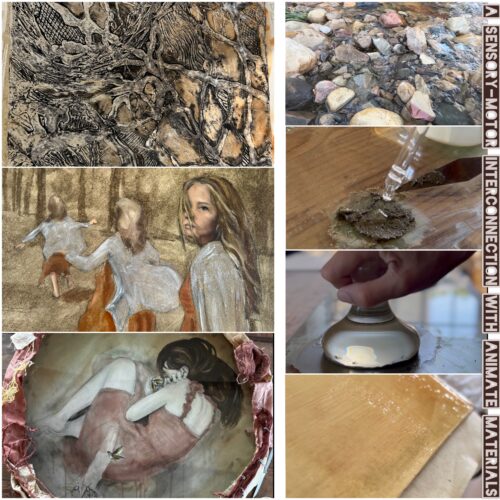
The Small Matter of Edges
Often, in the making of a piece of wall hung textile art, the finishing off stage can be surprisingly sticky. It will catch you out if you let it; everything goes so swimmingly well, and then, just as you come to nearly the end – what to do with those edges? Ideally, this is something which would have been considered early on at the design stages, but doesn’t it seem so obvious? 
Just a bit of matching binding around the edges and surely it’ll look OK? No, quite often it won’t and I can tell you that from sore personal experience! I remember completing the final assignment for the old Textiles 1 course, many, many years ago – and making just that mistake, not one that I repeated. I would be averse to point to anything negative in work from an OCA student or other textile artist, but I show you this of mine quite candidly.
The design was inspired by an Islamic vase in the Ashmolean Museum, where I worked at the time. I threw myself into the sketching with abandon, developing the design ideas, painting and stitching the dupion silk base. I had some painted silk fabric over and being in a hurry to complete the assignment, thought (how easy!) to use it to make a matching binding for the edges. Many of us fall into the trap of thinking we can “wing it” as inexperienced designers. If you look at the piece I think you’ll see now how that sweeping curve fights with the straight right angled edges. Repeating the same colours and textures in the centre and outer edges, draws your eye out in not a nice way. Those glaring areas of whiteness between the two elements creates unattractive shapes which your eyes are drawn to. Of course hindsight is a wonderful thing, and this was a great learning experience, as my tutor pointed out what must have been glaringly obvious to her.
Just before last Christmas, Katie Taylor, one of my face to face students, had come to the same point and asked for advice about where to go with her edges. Katie’s final piece was designed from some of her drawings of grasses. I have come to love these big, bold sweeping drawings, so full of life and movement. They don’t try to be neat or perfect or capture the exact appearance of grasses, but they do get that excited feeling down on paper with big, broad brushstrokes of near monocromatic colour. The marks are wonderfully expressive and convey what she feels about her subject matter. They have a organic, even quite basic strength to them. Putting a solid edging around the piece or (heaven forbid!) squaring it off would feel and look completely counter intuitive. Handling the edges in a more organic, unstructured way has kept that feeling of freedom and unrestrained energy. Look at the way the lines of machine embroidery thrust out into the margins, suggesting they can’t be controlled or reined in. 
Also notice how the layers which constitute the piece have been left exposed in the main; we are in no doubt that this is a textile piece – we can see the inner structure and strength of the piece.
Looking at the completed wallhanging, you will see the edging works with the piece instead of fighting it, the effect is natural because these design considerations have been thoroughly thought through and well executed.
You will be relieved to know, dear reader, that you are saved from the sight of my sad piece in its entirety.
Trisha Goodwin,Textiles tutor






Indeed I know this feeling well and it is so easy to want to frame a piece like we would a watercolour or oil. But isn’t it also fantastic that we have so many other options at out disposal in textile art, craft etc. Indeed Val Campbell Harding managed to do very well out of an entire book (Edges and Finishes) which I think barely scratched the surface of the possibilities.
But you are so right about planning the end right from the beginning. I guess its a bit like writing a book, you need to have a loose, but flexible idea of the whole story when you start writing or its going feel very disjointed when its complete. Easy to say but it takes a lot of self discipline to do, well it does for me!
Thank you again Trisha for your very kind comments. This was a bit of a lesson learnt for me. I too got carried away with the design process forgetting the edges, thinking it would be easy to consider this at the end. I quickly realised, and will now always consider the whole piece much earlier on. I am pleased with how it turned out but it was a bit stressful when it was for final piece for Textiles 1. Problems like this are part of a learning process that we all go through in one way or another!